Mumbai Metro
 | |||
| Overview | |||
|---|---|---|---|
| Native name | मुंबई मेट्रो | ||
| Owner | Mumbai Metropolitan Region Development Authority (MMRDA) | ||
| Locale | Mumbai, Maharashtra, India | ||
| Transit type | Rapid transit | ||
| Number of lines |
1 (operational)[1] 2(planned) 3(under construction) | ||
| Number of stations |
12 (operational) 58 (under construction) 82(approved) | ||
| Daily ridership | 277,000 (Line 1 average)[2] | ||
| Annual ridership | 100 million [3] | ||
| Website |
www | ||
| Operation | |||
| Began operation | 8 June 2014 (Line 1) | ||
| Operator(s) |
Mumbai Metro One Private Limited (Line 1) Mumbai Metro Rail Corporation Limited (Line 3) MMRDA(Line 2)(Line 4)(Line 5)(Line 6)(Line 7) | ||
| Train length | 4–8 coach trainsets[4] | ||
| Headway | 4–8 minutes | ||
| Technical | |||
| System length |
11.4 km (7.1 mi) (operational)[1] 101 km (63 mi) (planned) 68.5 km (42.6 mi)(under construction) | ||
| Track gauge | 1,435 mm (4 ft 8 1⁄2 in) (Standard gauge) | ||
| Electrification | 25 kV, 50 Hz AC through overhead catenary[5] | ||
| Average speed | 33 km/h (21 mph)[4] | ||
| Top speed | 80 km/h (50 mph)[4] | ||
| |||
Mumbai Metro is a rapid transit system serving the city of Mumbai, Maharashtra. The system is designed to reduce traffic congestion in the city, and supplement the overcrowded Mumbai Suburban Railway network. It will be built in three phases over a 15-year period, with overall completion expected in 2021. When complete, the core system will comprise three high-capacity metro railway lines, spanning a total of 63 kilometres (39 mi). Line 1 of the Mumbai Metro is operated by Metro One Operation Pvt Ltd (MOOPL), a joint venture company formed by RATP Développement, Transdev and Reliance Infrastructure, under a 35-year contract.[6] MOOPL operates under the control of Mumbai Metro One Private Limited (MMOPL), formed by Reliance and the Mumbai Metropolitan Region Development Authority (MMRDA).[6]
In June 2006, then-Prime Minister of India Manmohan Singh laid the foundation stone for the first phase of the Mumbai Metro project. Construction work began in February 2008.[7][8][9] A successful trial run was conducted in May 2013,[10][11][12] and the system's first line entered operation on 8 June 2014, though some aspects of the project were afflicted by delays and cost issues.[8][13][14][15]
History
Mumbai is the capital of Maharashtra, one of the most economically developed states of India. It is among the largest cities in the world, with a total metropolitan area population of over 20 million as of 2011,[16] and a population growth rate of around 2% per annum.[17] Mumbai has the uadvantage of a high modal share of the public (88%) in favour of a public mass transport system. The existing Mumbai Suburban Railway carries over 7 million passengers per day,[18] and is supplemented by the Brihanmumbai Electric Supply and Transport (BEST) bus system, which provides feeder services to station-going passengers to allow them to complete their journeys.Till 1980s the transport in Bombay was not a big problem .. After the discontinuation of trams resulted in the the pressure directly on suburban railway network .by the 2010 the population of Bombay doubled . However, due to the city's geographical constraints and rapid population growth, road and rail infrastructure development has not been able to keep pace with growing demand over the last 4-5 decades.[19] Moreover, the Mumbai Suburban Railway, though extensive, is not built to rapid transit specifications. The main objective of the Mumbai Metro is to provide mass rapid transit services to people within an approach distance of between 1 and 2 kilometres, and to serve the areas not connected by the existing Suburban Rail network.
| Phase | Line | Name of the corridor | Length (km) |
|---|---|---|---|
| Phase I (2006–2020) | 1 | Versova - Andheri – Ghatkopar | 11.07 |
| 2 | Bandra - Kurla – Mankhurd | 13.37 | |
| 3 | Colaba - Bandra – SEEPZ | 38.24 | |
| Phase II (2018–2023) | 4 | Charkop - Dahisar | 7.5 |
| 5 | Ghatkopar – Mulund | 12.4 | |
| Phase III (2018–2026) | 6 | BKC - Kanjur Marg via Airport | 9.5 |
| 7 | Andheri(E) - Dahisar(E) | 16.50 | |
| 8 | Hutatma Chowk – Ghatkopar | 21.8 | |
| 9 | Sewri – Prabhadevi | 3.5 |
The Government of Maharashtra through the MMRDA, in order to improve the traffic and transportation scenario in Mumbai and to cater to the future travel needs in the next 2-3 decades began exploring the viability of various alternative mass transit systems which are efficient, economically viable and environment friendly. In this context, a detailed feasibility study was carried out under Indo-German technical co-operation by entrusting the consultancy work to TEWET in association with DE-Consult and TCS, during 1997–2000. The study recommended a mass transit corridor from Andheri to Ghatkopar as potentially bankable and economically viable, after examining a number of alternative corridors and alignments. This study was updated by MMRDA in May 2004. Meanwhil ation (DMRC) prepared the master plan for Mumbai metro, wherein they recommended extending the Andheri-Ghatkopar section to Versova as part of the master plan and identified it as a priority corridor for implementation. The State Government declared the project as a "public vital infrastructure project" and designated the MMRDA as the Project Implementation Agency (PIA).[19] The master plan unveiled by the MMRDA in 2004 encompassed a total of 146.5 kilometres (91.0 mi) of track, of which 32 kilometres (20 mi) would be underground.[20] The Mumbai Metro was proposed to be built in three phases, at an estimated cost of ₹19,525 crore.[19] In September 2009, the proposed Hutatma Chowk – Ghatkopar was reduced to a line between Hutatma Chowk and Carnac Bunder.
In 2011, the MMRDA unveiled plans for an extended Colaba-Bandra-SEEPZ metro line. According to its earlier plans, a 20-km Colaba-to-Bandra metro line was to be constructed, running underground for 10 kilometres (6.2 mi) from Colaba to Mahalaxmi, and then on an elevated track from Mahalaxmi to Bandra. However, the MMRDA decided to increase ridership on the line by running it out past Bandra to Chatrapati Shivaji International Airport. The 33.5-kilometre (20.8 mi) Colaba-Bandra-SEEPZ line will be built at a cost of ₹21,000 crore (US$3.1 billion),[21] and will be the city's first underground metro line. It will have 27 stations.[22]
On 27 February 2012, the Union Government gave in-principle approval to the plan for Line 3. Money for the project is being borrowed from Japanese International Cooperation Agency (50%), the state government (16%), the central government (14%), and others.[23] In April 2012, the MMRDA announced plans to grant the Mumbai Metro Rail Company increased management autonomy, in an effort to enhance the project's operational efficiency.[24] In July 2012, the MMRDA announced plans to add more metro lines to its existing plan, including a line parallel to the Western Express Highway from Bandra to Dahisar. This line is expected to reduce the passenger load on the Western Line and vehicle traffic on the highway. Another proposed route, the 30-kilometre (19 mi), 28-station Wadala–Kasarvadvali line, received in-principle approval from the state government in 2013.[25] The MMRDA also intends to convert the proposed Lokhandwala–SEEPZ–Kanjurmarg monorail route into a metro line.[26]
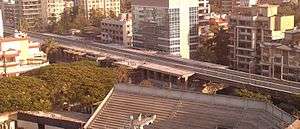
The Mumbai Metro master plan was revised by the MMRDA in 2012, increasing the total length of the proposed network to 160.90 km.[27] In June 2015, two new lines were proposed. A line from Andheri West to Dahisar West, and a line from BKC to Mankhurd.[28] The following table shows the updated master plan unveiled by the MMRDA:
| Line | Name of Corridor[29] | Length (km) | Estimated cost | Status |
|---|---|---|---|---|
| 1 | Versova–Andheri–Ghatkopar | 11.40 | ₹4,321 | Opened |
| 2 | Dahisar–Mankhurd | 42.1 | ₹17396
(in 2016) |
Under Construction and Approved |
| 2A | Dahisar-DN Nagar | 18.5 | ₹6,410 | Under Construction |
| 2B | DN Nagar-Mankhurd | 23.6 | ₹10,986 | Approved |
| 3 | Colaba - Bandra – SEEPZ | 33.5 | ₹24,430 | Under Construction |
| 4 | Wadala–Ghatkopar-Mulund–Teen Hath Naka–Kasarvadavali | 32 | ₹14,549 | Approved |
| 5 | Thane-Bhiwandi-Kalyan | 24 | ₹8,416 | Approved |
| 6 | Lokhandwala-Jogeshwari-Kanjurmarg | 14.5 | ₹6,672 | Approved |
| 7 | Andheri (East)-Dahisar (East) | 16.5 | ₹6,208 | Under Construction |
| Total | 174.00 | ₹81,992 crore |
On 18 February 2013, the MMRDA signed a memorandum of understanding with Transport for London, the transit authority in Greater London. The arrangement will facilitate the exchange of information, personnel and technology in the transportation sector.[30][31][32][33]
The revised Mumbai Metro master plan had proposed a line along the Thane-Teen Haath Naka-Kaapurbavdi-Ghodbunder Road route. The feasibility report concluded that the line was not feasible as most residents of Thane and its neighbouring areas travelled to Mumbai for work daily. On 14 June 2014, Chavan announced that the MMRDA was instead examining a proposal for a metro line along the new proposed route of Wadala-Ghatkopar-Teen Haat Naka route. RITES will prepare the detailed project report and is expected to submit it by August 2014. The preliminary report proposed a 32 km line with 29 stations, to be built at an estimated cost of ₹22,000 crore.[34] This would be the fourth line of the metro, after the previously proposed Charkop-Dahisar route was merged with the Charkop-Bandra-Mankhurd route to form Line 2.[35]

Following the opening of Line 1, MMRDA metropolitan commissioner UPS Madan stated that the authority would focus on constructing the Colaba-Bandra-SEEPZ, Dahisar-Bandra-Mankhurd, and Wadala-Thane-Kasarvadavali lines. He also stated that the other proposed lines had not been cancelled and that they may be implemented in the future.[36] In May 2015, the MMRDA stated that it had begun planning for the Andheri-Dahisar line and Seepz-Kanjurmarg. Both lines are expected to be elevated, although the latter could be constructed underground if a proposal to extend Line 3 to Kanjurmarg is undertaken. DPRs for both lines had been prepared in 2004, along with the master plan, and the MMRDA would now update the DPRs. The agency also intends to construct Line 9 of the metro as an underground corridor from Sewri to Worli. However, planning for the project will only begun after the construction of the proposed Mumbai Trans Harbour Link commences.[37]
In a report on 14 November 2014 about the cancellation of the PPP agreement for Line 2, Mint quoted a senior MMRDA official as stating, "as decided earlier, all future lines of Mumbai Metro will be constructed by the Mumbai Metro Railway Corp. Ltd (MMRCL), a joint venture between the state government and the Union government."[38] On 20 May 2015, Chief Minister Devendra Fadnavis requested officials to consider constructing the Charkop-Bandra-Dahisar and the Wadala-Thane-Kasarvadavali lines as elevated corridors. Although, both corridors had been planned as elevated lines in the Mumbai Metro master plan, the previous Congress-NCP had decided to construct all metro lines underground, after delays and difficulties caused by acquiring land for Line 1. However, Chief Minister Fadnavis believes that the two proposed lines can be constructed quicker and cheaper if they were elevated due to the proposed route of the alignment.[39] The Government plans to implement all future metro lines (except Line 3) as elevated corridors.[40] On 15 June 2015, the MMRDA announced that it would implement Line 2 of the metro in three parts. The Andheri-Dahisar line will have connectivity with the existing Line 1 and the proposed JVLR-Kanjurmarg line.[40]
In June 2015, Fadnavis announced that he would request the DMRC to assist in the implementation of the Mumbai Metro. He stated that he intends to expand the metro system by 109 km before the state assembly elections in October 2019.[41][42][43] In July 2015, UPS Madan announced that the State Government formally appointed the DMRC to revise and update the Mumbai Metro master plan. The DMRC will prepare DPRs for the Andheri East to Dahisar East, Jogeshwari to Kanjurmarg, Andheri West to Dahisar West and Bandra Kurla Complex to Mankhurd lines.[44] The Andheri-Dahisar line will have connectivity with the existing Line 1 and the proposed JVLR-Kanjurmarg line.[40] All four lines are proposed to be elevated and constructed as cash contracts. The lines are estimated to cost a total of ₹21,000 crore (US$3.1 billion), or about ₹350 crore (US$52 million) per km.[28] In addition, the planned Line 3 and Wadala-Ghatkopar-Thane-Kasarvadavli line of the metro would also be constructed.[44]
Network
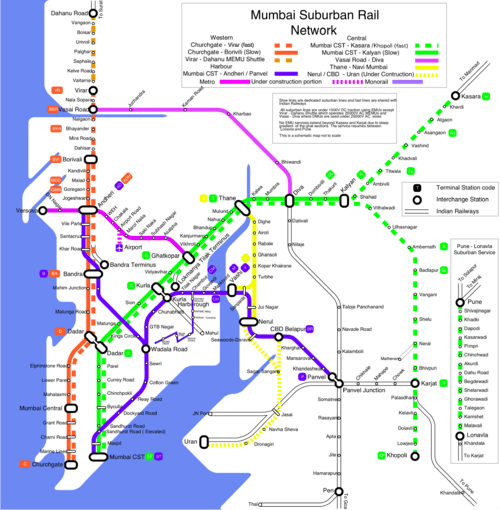
| Line | Terminal | Opening date | System length | Stations | |||||
|---|---|---|---|---|---|---|---|---|---|
| UG | Elevated | At grade | UG | Elevated | At grade | ||||
| Line 1 | Versova | Ghatkopar | 8 June 2014 | 0 km | 11.4 km | 0 km | 0 | 12 | 0 |
| Line 2 | Dahisar | Mankhurd | Under Construction | 0 km | 42.1 km | 0 km | 0 | 38 | 0 |
| Line 3 | Colaba | SEEPZ | Under Construction | 33 km | 0 km | 0 km | 26 | 0 | 1 |
| Line 4 | Wadala | Kasarvadavali | Approval | 0 km | 32 km | Approved | 30 | 0 | 0 |
| Line
5 |
Thane | Kalyan | Approved | 0 km | 24 km | 0 km | 0 | 17 | 0 |
| Line
6 |
Lokhandwala | Vikhroli | Approved | 0 km | 14.5 km | 0 km | 0 | 13 | 0 |
| Line
7 |
Andheri East | Dahisar East | Under Construction | 0 km | 16.5 km | 0 km | 0 | 16 | 0 |
Line 1
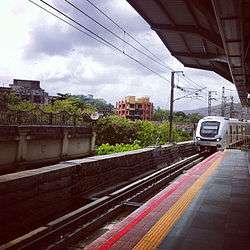

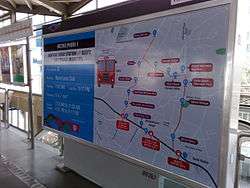
Line 1 connects Versova in the Western Suburbs to Ghatkopar in the Central Suburbs, covering a distance of 11.4 kilometres (7.1 mi).[1] It is fully elevated, and consists of 12 stations.[1] Work on the Versova-Andheri-Ghatkopar corridor, a part of Phase I, began on 8 February 2008. A crucial bridge on the project was completed at the end of 2012.[45] The line opened for service on 8 June 2014.[46] Line 1 of Mumbai Metro has 12 stations in the V-A-G corridor namely Versova, .D.N. Nagar, Azad Nagar, Andheri, Western Express Highway, .J.B. Nagar, Airport Road, Marol Naka, Saki Naka, Asalpha, Jagruti Nagar and Ghatkopar.
Line 2
This corridor would be executed in two phases i.e. 2A and 2B.
Line 2A
The 2A corridor will be 18.5 km long. The work is being executed by DMRC on behalf of MMRDA. The corridor has 16 stations.
The 16 stations are Anand Nagar, Rushi Sankul, I C Colony, Eksar, Don Bosco, Shimpoli, Mahavir Nagar, Kamraj Nagar, Charkop, Malad Metro, Kasturi Park, Bangur Nagar, Goregaon Metro, Adarsha Nagar, Shastri Nagar and DN Nagar.
The corridor will cost around ₹6,410 crore. Its civil work including viaduct and stations are being executed by JKumar Infra Pvt. Ltd.
The corridor is proposed to be ready by 2019. It will have interchange with Line 1 at DN Nagar and Line 7 at Dahisar.
Line 2B
The metro 2B corridor is being constructed from DN Nagar to Mankhurd. The project is estimated to cost Rs 10,970 crore, including land acquisition cost of Rs 1,274 crore. It will have 22 stations on route. It will cost ₹10,970 crores.
It was cleared by MMRDA in April 2016. It is awaiting cabinet approval after which civil work would start in 6-9 months. It is expected to be completed by 2021. Although it is planned to be made elevated, there are certain issues, such as the line running close to Juhu aerodrome or the dense corridors of Bandra West.
The corridor would be funded by Asian Development Bank(ADB).
Line 3
The second line to be constructed will be the 33.50 kilometre long Line 3. It will be the first underground metro line in Mumbai, and will consist of 27 stations.[48] The metro line will connect Cuffe Parade business district to SEEPZ.[49] It will also connect the Domestic and International airports of Mumbai. The cost of this corridor is estimated at ₹23,136 crore (US$3.4 billion).[50][51] The original deadline for the project was 2016, but it is currently expected to be completed in 2022. Construction to start in 2017. Tenders for civil work was awarded in July 2016.
Upon completion, it will have interchanges with Line 6 at SEEPZ, Line 1 at Marol Naka, Line 2 at BKC, Central railway at Chhatrapati Shivaji Terminus Mumbai Monorail at Mahalaxmi (Jacob circle), and Western Railway at Mahalaxmi, Mumbai Central and Churchgate.
Line 4
Metro 4 will be built across a 32-km corridor from Wadala to Kasarvadavali, near Thane, It will also be an elevated stretch. It is estimated to cost Rs 14,549 crore. With an aim to complete the project by 2021, the Authority has now recommended the project to the state government for final approval. This project will help connecting Thane area with the city of Mumbai with a new public transport system and will have a huge impact on the development and areas around the corridor.
The 32 station on the route are as Bhakti Park Metro, Wadala TT, Anik Nagar Bus Depot, Suman Nagar, Siddharth Colony, Amar Mahal Junction, Garodia Nagar, Pant Nagar, Laxmi Nagar, Shreyas Cinema, Godrej Company, Vikhroli Metro, Surya Nagar, Gandhi Nagar, Naval Housing, Bhandup Mahapalika, Bhandup Metro, Shangrila, Sonapur, Mulund Fire Station, Mulund Naka, Teen Haath Naka (Thane), RTO Thane, Mahapalika Marg, Cadbury Junction, Majiwada, Kapurbawdi, Manpada, Tikuji-ni-wadi, Dongri Pada, Vijay Garden, Kasarvadavali with 30-Hectare car deport at Owale.
Asian Development Bank has shown interest in funding this corridor. The corridor is expected to be ready by 2021.
Line 5
The 24-km-long Thane-Bhiwandi-Kalyan Metro-V corridor will have 17 stations and will cost Rs. 8,416 crore.
It will be totally an elevated corridor.It will connect Thane to Bhiwandi and Kalyan in the eastern suburbs.
The stations include Kapurbawdi in Thane (West), Balkum Naka, Kasheli, Kalher, Purna, Anjur Phata, Dhamankar Naka, Bhiwandi, Gopal Nagar, Temghar, Rajnouli Village, Govegaon MIDC, Kongaon, Durgadi Fort, Sahajanand Chowk, Kalyan railway station and Kalyan APMC.
It will be ready by 2021-22.
Line 6
The 14.5-km long Lokhandwala-Jogeshwari-Vikhroli-Kanjurmarg Metro-VI corridor will have 13 stations and cost Rs. 6,672 crore.
It will be an elevated corridor.It will connect Lokhandwala Complex in Andheri in the western suburbs to Vikhroli and Kanjurmarg in the eastern suburbs.
The stations include Lokhandwala Complex, Adarsh Nagar, Momin Nagar, JVLR, Shyam Nagar, Mahakali Caves, SEEPZ Village, Saki Vihar Road, Ram Baug, Powai Lake, IIT Powai, Kanjurmarg (W), Vikhroli-Eastern Express Highway.
It will be ready by 2021-22.
Line 7
The corridor is from Andheri East to Dahisar East. It is 16.5 km long. It was approved in September 2015. It is now under construction. It has 16 stations on route. It is completely an elevated corridor.
The 17 stations are kashimira, Dahisar (East), Ovaripada, National Park, Devipada, Magathane, Mahindra & Mahindra, Bandongri, Pushpa Park, Pathan Wadi, Dindoshi, Aarey, New Ashok Nagar, Mahanand, JVLR Junction, Shankarwadi, Andheri (East).
It is expected to cost ₹ 6,208 crores. It will be completed by 2019. Civil work, including viaduct and station works, is being executed by NCC, Simplex Infrastructure and JKumar Infra.
The corridor is being funded by Asian Development Bank. It would be ready by September 2019.
Infrastructure
.jpg)
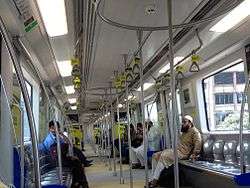

Rolling stock
RIIL consulted a number of major international rolling stock builders to provide the train fleet for the Mumbai Metro. Bidders for the contract included established metro-vehicle manufacturers such as Kawasaki, Alstom, Siemens and Bombardier, but CSR Nanjing of China was ultimately chosen to supply rolling stock for Rs 6 billion.[52][53] In May 2008, CSR Nanjing completed the first 16 trains, each comprising four cars.[54] The first ten trains were reported to be ready for operation in January 2013.[55]
The coaches are fire retardant,[56] air-conditioned and designed to reduce noise and vibration, and will feature both high seating capacity and ample space for standing passengers. They will be outfitted with a number of features for safety and convenience, including LCD screens, 3D route maps, first-aid kits, wheelchair facilities, fire-fighting equipment and intercom systems permitting communication with the train driver. Each coach will furthermore feature a black box to assist in accident investigations.[57] The trains will be capable of carrying over 1,100 passengers in a four-car unit, with each carriage being approximately 2.9 metres (9.5 ft) wide.[58]
Power
Unlike 97% of metro corridors worldwide which run on direct current (DC), the Mumbai Metro runs on alternating current (AC) which is more labour and cost intensive. MMRDA joint project director Dilip Kawathkar stated that AC power was chosen "after a proper study by a team of experts" which found that the AC model was "a better option". Bidders for Line 3 were reportedly in favour of the DC model. Experts believe that the decision to use AC will escalate the project cost of underground lines by 15%, since more digging is required for the rail to work on AC.[59]
Signalling and communications
The Mumbai Metro will feature an advanced signalling system, including an automatic train protection system (ATPS) and automated signalling to control train movements on the 11-kilometre (6.8 mi) Line 1. A four-minute service interval is anticipated on the route.[4]
Siemens will supply the signalling systems required for the project, while Thales Group will supply the Metro's communication systems. The network's signalling and train control systems will be based on LZB 700M technology.[60]
Ridership
A study in 2012 by Metro One and consultant MVA Systra estimated the daily ridership at 1.5 million, and it is estimated that the metro has seen 90 million annual passengers since it opened.[61] The average ridership is 2.77 lakh. Travel time from Versova to Ghatkopar is expected to be approximately 21 minutes.[57] Officials said that the maximum ridership recorded on a single day was 312,215 and minimum was 64,522. The Mumbai Metro witnessed service disruption two times between 2014 and 2015.[62]
See also
- Public transport in Mumbai
- Rapid transit in India
- Rail transport in India
- List of rapid transit systems
References
- 1 2 3 4 "Know Your Metro - Features". Reliance Mumbai Metro. Retrieved 8 June 2014.
- ↑ "5 crore travelled on Metro in six months". Times of India. Times News Network. Retrieved 12 December 2014.
- ↑ http://www.merinews.com/article/mumbai-metro-makes-it-to-100-million-commuters/15907971.shtml
- 1 2 3 4 "Mumbai Metro project". MMRDA. 1 January 2008. Retrieved 1 January 2010.
- ↑ "Overhead Metro wires to be charged". Hindustan Times. 27 February 2013. Retrieved 5 March 2013.
- 1 2 (French) "Mumbai inaugure son métro exploité par Transdev et RATP Dev". 10 June 2014. Retrieved 21 July 2015.
- ↑ "Mumbai monorail to be ready by Dec, Metro by March". Business Standard. 12 June 2012. Retrieved 7 July 2013.
- 1 2 "Mumbai's first metro may chug in 2013". DNA India. 6 May 2012. Retrieved 8 May 2012.
- ↑ "Metro, Monorail projects could miss deadline". The Indian Express. 14 August 2011. Retrieved 21 September 2011.
- ↑ "Mumbai: The connected city". Livemint. 20 June 2013. Retrieved 7 July 2013.
- ↑ "Mumbai Metro trial run successful". The Times Of India. 1 May. Retrieved 5 June 2013. Check date values in:
|date=(help) - ↑ "Mumbai Metro: trial run with train draped in flowers". NDTV. 1 May 2013. Retrieved 5 June 2013.
- ↑ "MMTPL to CM: Metro II will take more time, money". Mid-Day. 9 January 2012. Retrieved 12 January 2012.
- ↑ "Metro likely to miss its August deadline". DNA India. 6 March 2013. Retrieved 5 June 2013.
- ↑ "Indian Bank rejigs Mumbai Metro loan account". The Financial Express. 18 May 2012. Retrieved 23 May 2012.
- ↑ United Nations Population Division - City Population. Retrieved 5 October 2011.
- ↑ Average Annual Rate of Change. United Nations Population Division. Retrieved 5 October 2011.
- ↑ Mumbai Suburban Railway Network. Western Railway – Indian Railways. Updated 9 April 2012. Retrieved 26 April 2012.
- 1 2 3 4 "Mmrda – Projects – Mumbai Metro Rail Project". Mmrdamumbai.org. Archived from the original on 16 June 2014. Retrieved 12 March 2014.
- ↑ "Metro Rail-I to be operational in Mumbai in 2012". The Economic Times. 5 September 2011. Retrieved 24 October 2011.
- ↑ "Development body in talks with CSIA". The Indian Express. 14 January 2012. Retrieved 16 January 2012.
- ↑ "Views on Colaba-Seepz underground metro sought". DNA India. 14 December 2011. Retrieved 30 December 2011.
- ↑ "Centre paves way for 3rd Metro line". Times of India. 28 February 2012. Retrieved 28 March 2012.
- ↑ "Mumbai Metro likely to get autonomy status: MMRDA". DNA India. 27 April 2012. Retrieved 3 May 2012.
- ↑ "Soon, take a metro from south Mumbai to Thane". Hindustan Times. 23 April 2013. Retrieved 5 June 2013.
- ↑ "MMRDA to add more lines to Mumbai Metro railway project". DNA India. 8 July 2012. Retrieved 27 July 2012.
- ↑ http://www.thehindubusinessline.com/industry-and-economy/logistics/mumbai-metro3-launched-today/article6353788.ece
- 1 2 http://indianexpress.com/article/cities/mumbai/over-130-km-of-metro-lines-to-criss-cross-city-by-2020/99/
- ↑ "MMRDA - Mumbai Metro Master Plan". mmrda.maharashtra.gov.in. Retrieved 3 April 2014.
- ↑ "Mumbai transport body, London counterpart ink MoU". Business Line. 2 March 2013. Retrieved 5 June 2013.
- ↑ "MMRDA inks pact with UK transport authority". Indian Express. 19 February 2013. Retrieved 5 June 2013.
- ↑ "MMRDA, Transport for London ink MoU for under ground metro in Mumbai". Business Standard. 18 February 2013. Retrieved 5 June 2013.
- ↑ "Mumbai metro to run 150 km". Deccan Herald. 18 February 2013. Retrieved 5 June 2013.
- ↑ http://economictimes.indiatimes.com/industry/transportation/railways/mumbai-metro-services-to-be-extended-till-thane-prithviraj-chavan/articleshow/36547492.cms
- ↑ http://timesofindia.indiatimes.com/City/Mumbai/First-Metro-line-to-be-extended-to-Wadala-and-Thane/articleshow/36565838.cms
- ↑ http://indianexpress.com/article/cities/mumbai/mmrda-changes-decade-old-mumbai-metro-master-plan/
- ↑ http://www.hindustantimes.com/mumbai/mmrda-plans-two-new-metro-lines-for-mumbai/article1-1349401.aspx
- ↑ http://www.livemint.com/Companies/bKzM6yXoPKaxW1YelH9FBL/Reliance-Infra-pulls-out-of-Mumbai-Metro-Line-2.html
- ↑ http://indianexpress.com/article/cities/mumbai/mumbai-metro-rail-state-considers-elevated-metro-route/
- 1 2 3 http://www.hindustantimes.com/mumbai/metro-2-to-be-built-in-three-phases-2-other-routes-also-on-cards/article1-1359054.aspx
- ↑ http://www.financialexpress.com/article/economy/devendra-fadnavis-plans-to-ask-dmrc-team-to-assist-in-metro-expansion/82971/
- ↑ http://www.business-standard.com/article/economy-policy/mumbai-metro-seeks-delhi-counterpart-s-help-to-expedite-project-115061500504_1.html
- ↑ http://indianexpress.com/article/business/business-others/pan-mumbai-metro-network-by-2019-targets-maharashtra/
- 1 2 http://www.dnaindia.com/mumbai/report-mumbai-metro-master-plan-maharashtra-government-nod-for-delhi-body-revise-and-update-blueprint-2100949
- ↑ "Metro ride in June '13? Work on crucial bridge completed". The Times of India. 26 December 2012. Retrieved 6 January 2013.
- ↑ "Maharashtra CM Prithivraj Chavan flags off Mumbai Metro". The Times of India. 8 June 2014. Retrieved 8 June 2014.
- ↑ http://www.hindustantimes.com/mumbai-news/construction-of-two-metro-lines-to-begin-mid-monsoon/story-npNUP13d2rN6CsqgBtdRMM.html
- ↑ "Cabinet clears Mumbai Metro's third line". Times of India. 29 June 2013. Retrieved 7 July 2013.
- ↑ "Further delay in Colaba-Seepz metro as govt tweaks bid norms | Business Standard". business-standard.com. Retrieved 3 April 2014.
- ↑ "Mumbai Metro Line 3 plan kicks off". Mumbai Mirror. 29 June 2013. Retrieved 7 July 2013.
- ↑ "Cabinet approves Mumbai Metro Line 3: FM". Zee News. 28 June 2013. Retrieved 7 July 2013.
- ↑ Mumbai's beautiful butterfly emerges. Railway Gazette. Retrieved on 6 December 2013.
- ↑ "Mumbai Metro One Project updates". mumbai-metro.com. Retrieved 25 August 2010.
- ↑ "Mumbai's beautiful butterfly emerges". Railway Gazette. 25 March 2010. Retrieved 24 October 2011.
- ↑ "Mumbai metro trains raring to run, but where are tracks?". DNAIndia. 23 January 2013. Retrieved 6 February 2013.
- ↑ "A Mumbai Metro train every three minutes". DNA India. 1 May 2013. Retrieved 7 July 2013.
- 1 2 "Metro first line hinges on Andheri bridge". Times of India. 11 October 2011. Retrieved 18 October 2011.
- ↑ Katkurwar, Saurabh (26 February 2012). "CIDCO opts for wider metro coaches". MiD DAY. Retrieved 28 March 2012.
- ↑ http://www.mid-day.com/articles/mumbais-metro-3-will-be-one-of-the-few-in-the-world-to-run-on-ac/15298168
- ↑ "MMOPL awards contract to ABB, Siemens, SEW". Projects Today. 8 January 2008. Retrieved 15 January 2010.
- ↑ "Mumbai Metro may get 44 extra coaches from China". The Times Of India. 31 March 2012.
- ↑ "Mumbai Metro ridership and service disruption". OnlineRTI. 12 June 2015.
External links
| Wikimedia Commons has media related to Mumbai Metro. |
